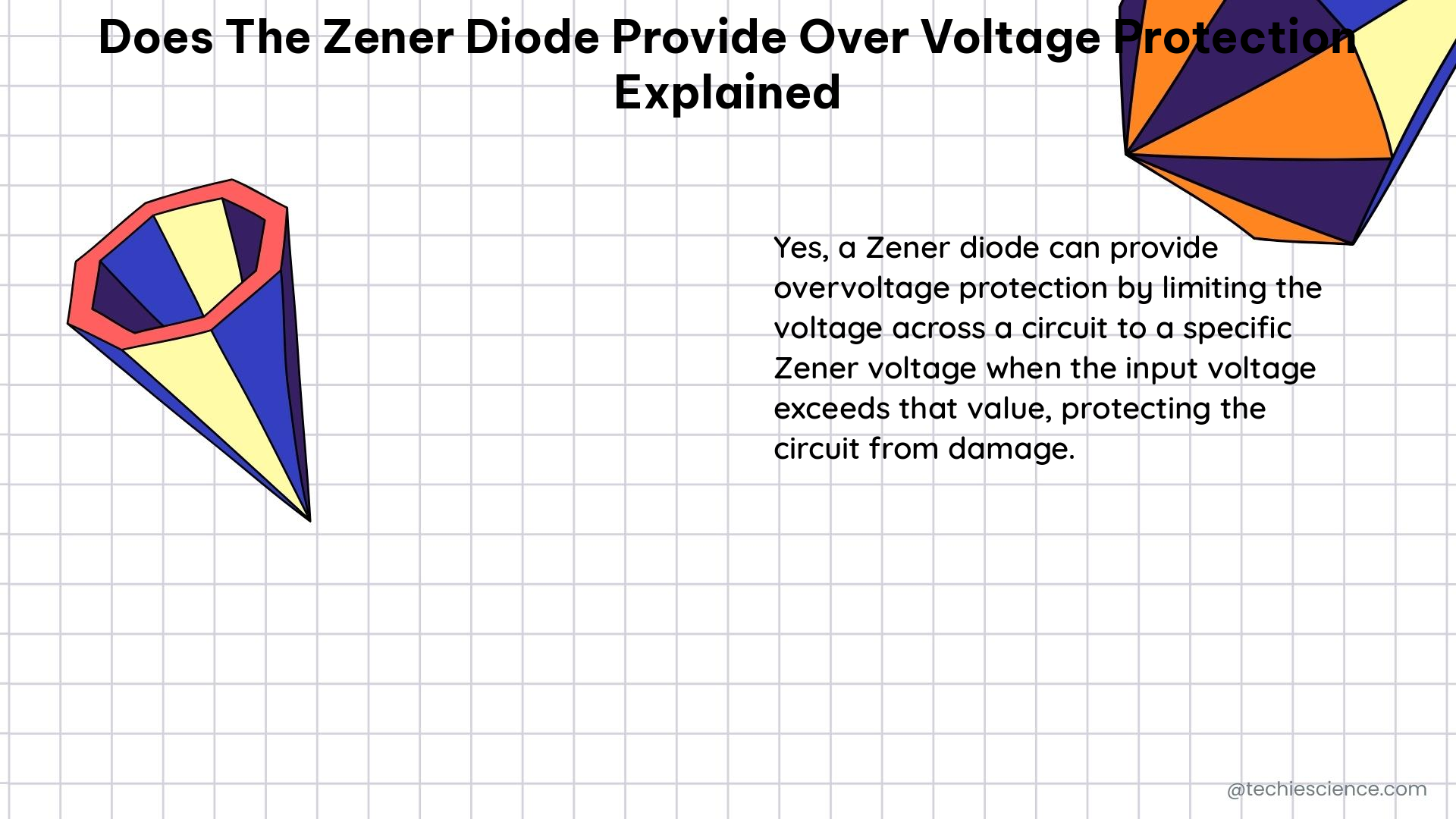The Zener diode is a widely used semiconductor device that provides overvoltage protection in circuits by regulating the voltage and limiting the current flow. It operates based on the Zener effect, where a reverse-biased Zener diode allows current to flow in the reverse direction when the voltage reaches the Zener voltage (Vz). This article will provide a comprehensive understanding of how the Zener diode’s technical specifications, such as Zener voltage, power rating, and current rating, determine its ability to provide effective overvoltage protection.
Understanding Zener Voltage (Vz)
The Zener voltage (Vz) is the critical parameter that defines the voltage level at which the Zener diode starts conducting current in the reverse direction. This voltage level is the key to the Zener diode’s overvoltage protection capabilities.
- Zener voltage is typically specified in the range of 2.4V to 200V, with common values being 3.3V, 5.1V, 6.2V, 9.1V, and 12V.
- When the voltage across the Zener diode reaches the Zener voltage, the diode starts conducting current in the reverse direction, effectively clamping the voltage at the Zener voltage level.
- For example, a 5.1V Zener diode will start conducting current in the reverse direction when the voltage reaches 5.1V, protecting the circuit from any voltage above this level.
- The Zener voltage is determined by the semiconductor material and the doping concentration used in the diode’s construction. Higher doping concentrations result in lower Zener voltages.
Zener Diode Power Rating (Pz)

The power rating (Pz) of a Zener diode is the maximum power that the diode can dissipate without getting damaged. This parameter is crucial when selecting a Zener diode for overvoltage protection.
- The power rating is determined by the total current flowing through the diode and the voltage drop across it, as per the formula: Pz = Iz × Vz, where Iz is the current flowing through the diode and Vz is the Zener voltage.
- Common Zener diode power ratings range from 250 milliwatts (0.25W) to 50 watts (50W), with 1W and 5W being the most commonly used.
- When selecting a Zener diode for overvoltage protection, it is essential to choose a diode with a power rating that can handle the maximum expected power dissipation in the circuit. Exceeding the power rating can lead to the diode’s failure and potential damage to the protected circuit.
Zener Diode Current Rating (Iz)
The current rating (Iz) of a Zener diode is the maximum current that the diode can handle without getting damaged. This parameter is also crucial when selecting a Zener diode for overvoltage protection.
- The current rating is determined by the diode’s physical characteristics, such as its size and material.
- Common Zener diode current ratings range from a few milliamps (mA) to several amps (A), with 50mA, 100mA, and 500mA being the most commonly used.
- When selecting a Zener diode for overvoltage protection, it is crucial to choose a diode with a current rating that can handle the maximum expected current in the circuit. Exceeding the current rating can lead to the diode’s failure and potential damage to the protected circuit.
Enhancing Zener Diode Overvoltage Protection with a Series Resistor
The Zener diode’s overvoltage protection capability can be further enhanced by adding a series resistor to limit the current flowing through the diode.
- The value of the series resistor can be calculated using Ohm’s law: R = (Vmax – Vz) / Imax, where R is the resistor value, Vmax is the maximum expected voltage, Vz is the Zener voltage, and Imax is the maximum expected current.
- For example, consider a circuit that requires overvoltage protection for a microcontroller with a maximum voltage rating of 5V. A 5.1V Zener diode can be used to protect the microcontroller from any voltage above 5.1V.
- Assuming the diode has a power rating of 1W and a Zener voltage of 5.1V, the maximum current that can flow through the diode is 1W/5.1V = 196mA.
- To limit the current to a value below the diode’s maximum current rating, a series resistor can be added. If the maximum expected current is 50mA, the required series resistor value would be (5.1V – 5V) / 0.05A = 20Ω.
By understanding the Zener diode’s technical specifications and applying them correctly in a circuit, you can ensure reliable overvoltage protection for your electronic devices.
References:
- How Does Zener Diode Do Overvoltage Protection in Circuit? (2021, February 3). RS Online. https://www.rs-online.com/designspark/how-does-zener-diode-do-overvoltage-protection-in-circuit
- Zener Diode for overvoltage protection – Electronics Stack Exchange (2016, March 2). Electronics Stack Exchange. https://electronics.stackexchange.com/questions/220317/zener-diode-for-overvoltage-protection
- Zener diode over voltage protection : r/ElectricalEngineering – Reddit (2023, October 9). Reddit. https://www.reddit.com/r/ElectricalEngineering/comments/173somb/zener_diode_over_voltage_protection/
- Using Zener diode as over voltage protection for LED – Arduino Forum (2021, August 1). Arduino Forum. https://forum.arduino.cc/t/using-zener-diode-as-over-voltage-protection-for-led/891277
- Overvoltage protection circuit specification. Zener diodes… what wattage. All About Circuits Forum (2020, October 10). https://forum.allaboutcircuits.com/threads/overvoltage-protection-circuit-specification-zener-diodes-what-wattage.173316/page-2

The lambdageeks.com Core SME Team is a group of experienced subject matter experts from diverse scientific and technical fields including Physics, Chemistry, Technology,Electronics & Electrical Engineering, Automotive, Mechanical Engineering. Our team collaborates to create high-quality, well-researched articles on a wide range of science and technology topics for the lambdageeks.com website.
All Our Senior SME are having more than 7 Years of experience in the respective fields . They are either Working Industry Professionals or assocaited With different Universities. Refer Our Authors Page to get to know About our Core SMEs.